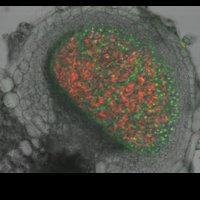Dennis Berg Holt: Exploring the bacterial root symbiosis in legumes – small RNAs involved in infection and nodulation
PhD defence, Tuesday 16 December 2014. Dennis Berg Holt.

Legume plants have the ability to interact with rhizobial bacteria to form nitrogen-fixing root nodules, which render them independent of soil-borne nitrogen sources. Small RNAs including micro RNAs (miRNAs) have emerged as important factors in plant responses to microbial interactors.
My research identifies and characterises small RNAs potentially involved in nodule symbiosis of the model legume Lotus japonicus (Lotus) and its bacterial symbionts.
The PhD degree was completed at Centre for Carbohydrate Recognition and Signalling (CARB), Department of Molecular Biology and Genetics, Science and Technology, Aarhus University.
This résumé is prepared by the PhD student.
Time: Tuesday 16 December 2014 at 13.15
Place: Building 1252, room 204, Eduard Biermann Lecture Theatre, Bartholins Allé 3, Aarhus University
Title of dissertation: Small RNAs involved in bacterial root symbiosis in Lotus japonicus
Contact information: Dennis Berg Holt, e-mail: dennis@mbg.au.dk, tel.: +45 51218925
Members of the assessment committee:
Professor Franziska Krajinski, Max Planck Research Group, Max Planck Institute of Molecular Plant Physiology, Potsdam, Germany.
Associate Professor Peter Brodersen, Department of Biology, University of Copenhagen, Denmark.
Professor Claus Oxvig (chair), Department of Molecular Biology and Genetics, Aarhus University, Denmark.
Main supervisor:
Professor Jens Stougaard, CARB, Department of Molecular Biology and Genetics, Aarhus University, Denmark.
Co-supervisor:
Post-Doc Katharina Markmann, CARB, Department of Molecular Biology and Genetics, Aarhus University, Denmark.
Language: The PhD dissertation will be defended in English.
The defence is public.
Promoter activity of a miRNA precursor (MIR) gene analysed in this study.
Example of a MIR gene strongly induced by bacterial infection in Lotus roots and nodules. Tissue section of an immature nodule nine days post infection with rhizobial bacteria expressing a red fluorescent protein. Green fluorescence shows activity of the MIR gene promoter, which expresses a nuclear localised green fluorescent protein.
